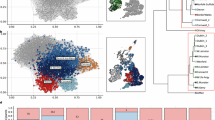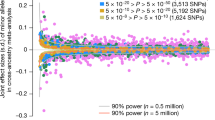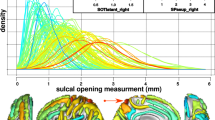Abstract
The recent completion of the International HapMap Project has rapidly advanced our understanding of linkage disequilibrium (LD) in the human genome. Today, tagging SNPs (tSNPs) can be quickly and easily selected and consequently HapMap data are regularly applied to both small- and large-scale genetic mapping studies. However, to correctly interpret the application of HapMap-derived tSNPs in a genetic mapping study, an understanding of how well HapMap data represents LD in the study population is critical. The Irish population had not previously been characterised in this way. Here, we do so using a set of 4424 SNPs selected from 279 candidate genes for epilepsy genotyped across 1118 healthy individuals from the Irish, British, Finnish and Australian populations. By considering the Irish population alongside surrounding European populations, our results confirm that the HapMap European-derived population accurately estimates patterning of LD in European descent populations. The Irish population appears notably well matched to the European HapMap population, and is markedly similar to the neighbouring British population. Although we were unable to detect significant substructure within the Irish population (a favourable result for genetic mapping), methods for controlling stratification should always be incorporated. This analysis therefore confirms that the genetic architecture of the Irish population is well suited to the study of complex traits and that tSNPs selected using the HapMap data can be confidently applied to the Irish population.
Similar content being viewed by others
Log in or create a free account to read this content
Gain free access to this article, as well as selected content from this journal and more on nature.com
or
References
The International HapMap Consortium: A second generation human haplotype map of over 3.1 million SNPs. Nature 2007; 449: 851–861.
The International HapMap Consortium: A haplotype map of the human genome. Nature 2005; 437: 1299–1320.
Cavalleri GL, Weale ME, Shianna KV et al: Multicentre search for genetic susceptibility loci in sporadic epilepsy syndrome and seizure types: a case–control study. Lancet Neurol 2007; 6: 970–980.
Conrad DF, Jakobsson M, Coop G et al: A worldwide survey of haplotype variation and linkage disequilibrium in the human genome. Nat Genet 2006; 38: 1251–1260.
Gonzalez-Neira A, Ke X, Lao O et al: The portability of tagSNPs across populations: a worldwide survey. Genome Res 2006; 16: 323–330.
Ribas G, Gonzalez-Neira A, Salas A et al: Evaluating HapMap SNP data transferability in a large-scale genotyping project involving 175 cancer-associated genes. Hum Genet 2006; 118: 669–679.
Smith EM, Wang X, Littrell J et al: Comparison of linkage disequilibrium patterns between the HapMap CEPH samples and a family-based cohort of Northern European descent. Genomics 2006; 88: 407–414.
Mueller JC, Lohmussaar E, Magi R et al: Linkage disequilibrium patterns and tagSNP transferability among European populations. Am J Hum Genet 2005; 76: 387–398.
de Bakker PI, Burtt NP, Graham RR et al: Transferability of tag SNPs in genetic association studies in multiple populations. Nat Genet 2006; 38: 1298–1303.
Hill EW, Jobling MA, Bradley DG : Y-chromosome variation and Irish origins. Nature 2000; 404: 351–352.
McEvoy B, Richards M, Forster P, Bradley DG : The Longue Duée of genetic ancestry: multiple genetic marker systems and celtic origins on the Atlantic facade of Europe. Am J Hum Genet 2004; 75: 693–702.
Helgason A, Hickey E, Goodacre S et al: mtDna and the islands of the North Atlantic: estimating the proportions of Norse and Gaelic ancestry. Am J Hum Genet 2001; 68: 723–737.
Semino O, Passarino G, Oefner PJ et al: The genetic legacy of Paleolithic Homo sapiens sapiens in extant Europeans: a Y chromosome perspective. Science 2000; 290: 1155–1159.
Wilson JF, Weiss DA, Richards M, Thomas MG, Bradman N, Goldstein DB : Genetic evidence for different male and female roles during cultural transitions in the British Isles. Proc Natl Acad Sci USA 2001; 98: 5078–5083.
O'Brien E, Murphy J, Tyndall A et al: Twenty-four-hour ambulatory blood pressure in men and women aged 17–80 years: the Allied Irish Bank Study. J Hypertens 1991; 9: 355–360.
Liu K, Muse SV : PowerMarker: an integrated analysis environment for genetic marker analysis. Bioinformatics 2005; 21: 2128–2129.
Barrett JC, Fry B, Maller J, Daly MJ : Haploview: analysis and visualization of LD and haplotype maps. Bioinformatics 2005; 21: 263–265.
Gabriel SB, Schaffner SF, Nguyen H et al: The structure of haplotype blocks in the human genome. Science 2002; 296: 2225–2229.
Nei M, Tajima F : DNA polymorphism detectable by restriction endonucleases. Genetics 1981; 97: 145–163.
The R Project for Statistical Computing. [http://www.r-project.org/].
Devlin B, Roeder K : Genomic control for association studies. Biometrics 1999; 55: 997–1004.
Vitart V, Carothers AD, Hayward C et al: Increased level of linkage disequilibrium in rural compared with urban communities: a factor to consider in association-study design. Am J Hum Genet 2005; 76: 763–772.
The Wellcome Trust Case-Control Consortium: Genome-wide association study of 14 000 cases of seven common diseases and 3000 shared controls. Nature 2007; 447: 661–678.
Dolan C, O'Halloran A, Bradley DG et al: Genetic stratification of pathogen-response-related and other variants within a homogeneous Caucasian Irish population. Eur J Hum Genet 2005; 13: 798–806.
Moore LT, McEvoy B, Cape E, Simms K, Bradley DG : A y-chromosome signature of hegemony in gaelic ireland. Am J Hum Genet 2006; 78: 334–338.
Bauchet M, McEvoy B, Pearson LN et al: Measuring European population stratification with microarray genotype data. Am J Hum Genet 2007; 80: 948–956.
Cavalli-Sforza LL : The History and Geography of Human Genes. Princeton University Press, 1994.
Acknowledgements
This work was partly supported by PRTLI3 (ND, CD,GLC) and a MRC grant (SMS, DBG). The work was partly undertaken at UCLH/UCL who received a proportion of funding from the UK Department of Health's NIHR Biomedical Research Centre's funding scheme. GSK Research and Development provided funding for the recruitment of the Finnish subjects. We thank John C Mulley of the Department of Medicine, University of Adelaide, Australia, for contributing Australian DNA samples. We thank two anonymous reviewers for their constructive comments.
Author information
Authors and Affiliations
Corresponding author
Additional information
Supplementary Information accompanies the paper on European Journal of Human Genetics website (http://www.nature.com/ejhg)
Rights and permissions
About this article
Cite this article
O'Dushlaine, C., Dolan, C., Weale, M. et al. An assessment of the Irish population for large-scale genetic mapping studies involving epilepsy and other complex diseases. Eur J Hum Genet 16, 176–183 (2008). https://doi.org/10.1038/sj.ejhg.5201938
Received:
Revised:
Accepted:
Published:
Issue date:
DOI: https://doi.org/10.1038/sj.ejhg.5201938
Keywords
This article is cited by
-
Familial breast cancer genetic testing in the West of Ireland
Irish Journal of Medical Science (2014)
-
Replication of association between schizophrenia and ZNF804A in the Irish Case–Control Study of Schizophrenia sample
Molecular Psychiatry (2010)



